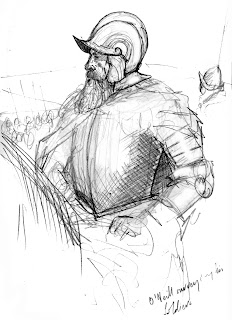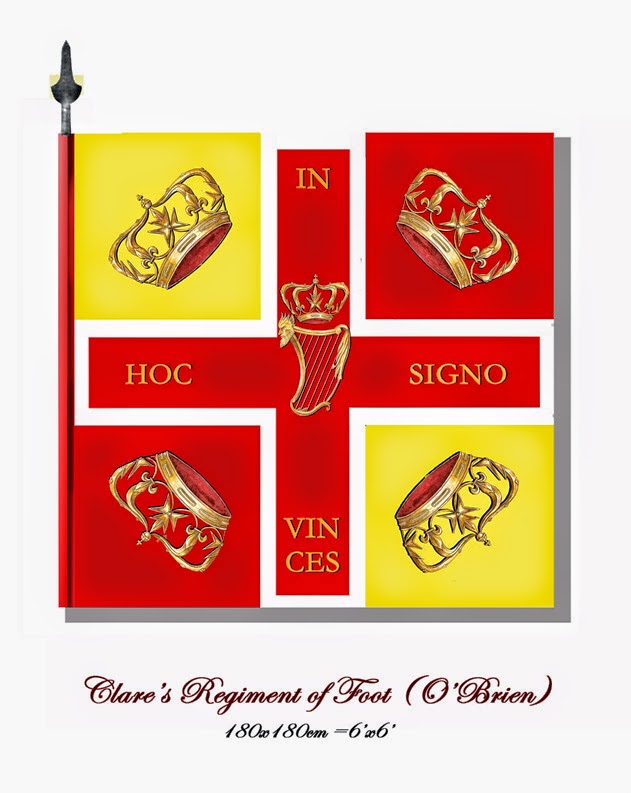HUGH O'NEILL 1540-1616
MEMENTO MORI
Annal Four Masters
After Ulster was cleared of the Gaelic hierarchy and moire where to follow in the service of Spain in Flanders, filling the Irish regiments. So the English began to colonise Ireland with English, Welsh and Scots settlers, many of the lessons learned in these colonising efforts would be used in the parallel colonisation of settlers in the New World c.1608.
The last gasp of O'Neill was the death knell of the old Gaelic order and the beginning of new reality for the Irish people, under new Lords, subservient to the new settlers and having to readjust to new system of governance, laws, religion, language and culture, imposed from across the water.
On the 20 July 1616, news comes from Rome, Hugh O'Neill, the Great O'Neill, 2nd Earl of Tyrone is dead. To the Crown in London, it was a great relief as the spectre of O'Neill in exile conspiring with foreign powers, gathering a foreign army of emigrés and mercenaries, was unsettling with the momentum of colonisation of Gaelic lands only beginning to gain traction.
But O'Neill's death cannot be underestimated within Gaelic society, it caused much consternation, a realisation that the recent changes would now remain and the new reality of a foreign Hierarchy with the influx of colonist from Britain, had reduced many to bottom rung of the new society, with the a glimmer of a return to the old order getting dimmer. O'Neill's death even created a schism of sorts within the Bardic tradition, known as "the contention of the Bards".
The long unbroken chain of ancient Gaelic clan power and hegemony, was now broken, scattered and the hope of a resurgence had essentially expired with O'Neill on his death bed. Here is the entry in the Annal's of the four masters concerning O'Neill's death;
Annal Four Masters
THE AGE OF CHRIST, 1616. The Age of Christ, one thousand six hundred sixteen
M1616.1
"O'Neill (Hugh, son of Ferdorcha, son of Con Bacagh, son of Con, son of
Henry, son of Owen), who had been Baron from the death of his father to
the year when the celebrated Parliament was held in Dublin, 1584 recte
1585, and who was styled Earl of Tyrone at that Parliament, and who was
afterwards styled O'Neill, died at an advanced age, after having passed
his life in prosperity and happiness, in valiant and illustrious
achievements, in honour and nobleness. The place at which he died was
Rome, and his death occurred on the 20th of July, after exemplary
penance for his sins, and gaining the victory over the world and the
Devil. Although he died far from Armagh, the burial-place of his
ancestors, it was a token that God was pleased with his life that the
Lord permitted him a no worse burial-place, namely, Rome, the head city
of the Christians. The person who here died was a powerful, mighty lord,
endowed"
Background
 |
| Battle of Ballyshannon 1597 |
Hugh O'Neill, was a Gaelic Lord, born c.1540. He was made Earl of Tyrone by succeeding his uncle Turlough Luineach O'Neill, who relinquished his claim to "the O'Neill" leaving it available to Hugh. As Hugh was the grandson of Conn Bacach O'Neill, the 1st Earl of Tyrone by the English, but the O'Neill under the Gaelic System, Hugh then became 2nd Earl of Tyrone, but also "the O'Neill" and he would eventually be the last to be inaugurated at the Ancient site of Tullyhogue, near Cookstown. Sir Phelim O'Neill, was also inaugurated there, but this is not recognised.
O'Neill's career was played out against the
background of the "Tudor re-conquest of Ireland", the "Anglo-Spanish war", the "Armada", aswell as the brutal and bloody "80 year war" in Low Countries (modern Belgium & Netherlands). But he is best known for his resistance to the Elizabethan conquest in Ireland and particularly for joining Red Hugh O'Donnell in trying to defend their lands in the Province of Ulster.
He was raised by the Hovendens in the Pale (English enclave around Dublin). But was supported by he English in Tyrone. After playing a double game, supporting and conspiring against English authority, he eventually came out in rebellion along with other Gaelic lords and fought a gruelling 9 year war against the English and their Irish allies.
After succeeding in the early stages of defeating various English armies militarily, through diplomacy and guile kept the English out of Ulster for most of period, while appealing to Spain for assistance under the auspices of the casus belli of the "Counter reformation".
Eventually the Spanish landed an army at Kinsale in 1601, rather than in Ulster where they could have been of use. This force was besieged by the English who surrounded the town. So the Ulster lords made the fateful decision to march to Kinsale from Ulster to help the Spanish, but were defeated by the English and had to make their way back North, while Aodh Rua O'Donnell went to Spain were it is assumed he was poisoned in 1603.
After succeeding in the early stages of defeating various English armies militarily, through diplomacy and guile kept the English out of Ulster for most of period, while appealing to Spain for assistance under the auspices of the casus belli of the "Counter reformation".
 |
| Book jacket "Plantation of Ulster Vis Centre", Artist Collection |
The end was now at hand, as Dowcra established a fort in pestilential fort of Derry and Mountjoy came up from the south into Armagh, so gradually closing the pincher, with Chichester also raiding with his riverine force on Lough Neagh.
O'Neill was forced to burn Dungannon and take to the forests and mountian fastness, eventually coming in and submitted to Mountjoy at Mellifont Abbey in 1603. It wasn't until after he accepted terms, he discovered Queen Elizabeth I was dead and James I was now the new Monarch on the throne of the 3 kingdoms. There was high hope due to James I lineage, he may be favourably disposed towards the Gaelic Irish, but this turned out to be wishful thinking.
O'Neill was forced to burn Dungannon and take to the forests and mountian fastness, eventually coming in and submitted to Mountjoy at Mellifont Abbey in 1603. It wasn't until after he accepted terms, he discovered Queen Elizabeth I was dead and James I was now the new Monarch on the throne of the 3 kingdoms. There was high hope due to James I lineage, he may be favourably disposed towards the Gaelic Irish, but this turned out to be wishful thinking.
In 1607 it became clear to O'Neill and the other Gaelic Lords their positions, where under threat and they decided to leave Ireland, regroup abroad and return. So Chuconnacht McGuire hired a ship and the remaining Earls with a select retainers left from Rathmullan in September 1607 bound for La Corunna, Spain.
 |
| "Earl's route to Rome 1607" An Post 2007 |
Unfortunately due to storms they ended up landing at Quilleboeuf in Northern France, there following various deputations, they decided to take the land route through friendly territory south to Rome. Shortly after arriving, O'Neill was féted (as shown in the Fresco in the Vatican), but Rory O'Donnell died soon after arrival.
By the time the Earl's had fled real politic had overtaken them, as Spain and England made a peace, thus nullifying a chance of gaining any meaningful material support for the Earls cause.
So like Prometheus, O'Neill would languish in the sacred City, until 1616 to ponder his own destiny. Eventually dying aged 76, on the 20th of July 1616 after taking the robes. After surviving many of his rival, but never having been able to return to Ireland, it is interesting to ponder the what ifs?
| setennets stamp in first day cover, copyright An Post 2007 |
By the time the Earl's had fled real politic had overtaken them, as Spain and England made a peace, thus nullifying a chance of gaining any meaningful material support for the Earls cause.
| first day cover, copyright An Post 2007 |
 |
| "Hugh O'Neill" copyright An Post 2007 |
After Ulster was cleared of the Gaelic hierarchy and moire where to follow in the service of Spain in Flanders, filling the Irish regiments. So the English began to colonise Ireland with English, Welsh and Scots settlers, many of the lessons learned in these colonising efforts would be used in the parallel colonisation of settlers in the New World c.1608.
 |
| "Rory & Hugh being rowed to ship" pen study, unknown |
 |
| "O'Neill bidding farewell to local people", pencil study, Artist collection |
 |
| book jacket artwork "Imeacht na nÍarlaí" by Marcus O'Murchu, Private Collection |
 |
| "Earls being rowed to ship", Seán Ó'Brógáin, Private collection |
 |
| preliminary study, Artist collection |
 |
| preliminary study, Artist collection |
 |
| "O'Neill" from "The Flight of the Earls, an illustrated History" |
 |
| Preliminary sketch of "O'Neill", Artist collection |
 | ||
| "3 heroes" from "The Flight of the Earls, an illustrated History" |
 |
| book jacket design "The Flight of the Earls, an illustrated History" by Dr. John McCavitt |
The Flight of The Earls: Imeacht na nIarlaí
|
This was launched in Feb 2007 alas as it was launched 5 days before the price change the stamps as current stamp died a death as one had to buy a 5cent stamp to add enable to use the stamps on mail. this led to a number of other jobs involving the Earls including John McCavitt's self published book "the flight of the Earls, an illustrated hisorty".
My work along with some unused pieces, were in cluded in Dr. Eamon O'Ciardha's "flight of the Earls" publication, Marcus O'Murchu's commisioned me to do a piece for his book "imeacht na nÍarlaí" and i illustrated the information boards for the "hill of the O'Neill's" visitor centre, Ranfurly House, Dungannon.
In conclusion
So on this day, i include my "MEMENTO MORI" to him. I have included a fairly large selection of work (above) but not all) of someone who has been an intriguing character for me to illustrate and his star has shone brightly on my work for a number of years.
 |
| "in progress" oil study "Hugh O'Neill" c.1616, copyright Sean Ó' Brógáin 2016 |
D.O.M
HVGONIS.PRINCIPIS.ONELLI
"Aodh Ó' Néill, í buanchuimhne ar na gníomh
gaiscíochta agus ar a anam..."
gaiscíochta agus ar a anam..."
Links
http://www.theflightoftheearls.net/overview.html
http://oneillcountryhistoricalsociety.com/
http://www.ricorso.net/rx/az-data/authors/o/ONeill_H1/life.htm
http://www.historyireland.com/early-modern-history-1500-1700/flight-of-the-earls-changing-views-on-oneills-departure-from-ireland/
https://en.wikipedia.org/wiki/Niall_of_the_Nine_Hostages
https://en.wikipedia.org/wiki/Northern_U%C3%AD_N%C3%A9ill
https://en.wikipedia.org/wiki/O%27Neill_dynasty
https://en.wikipedia.org/wiki/Nine_Years%27_War_(Ireland)
https://en.wikipedia.org/wiki/Arthur_Chichester,_1st_Baron_Chichester
https://en.wikipedia.org/wiki/Maguire_(surname)
https://en.wikipedia.org/wiki/Anglo-Spanish_War_(1585%E2%80%931604)
https://en.wikipedia.org/wiki/Nine_Years%27_War_(Ireland)
https://en.wikipedia.org/wiki/Arthur_Chichester,_1st_Baron_Chichester
https://en.wikipedia.org/wiki/Maguire_(surname)
https://en.wikipedia.org/wiki/Anglo-Spanish_War_(1585%E2%80%931604)
https://en.wikipedia.org/wiki/Tullyhogue_Fort
https://en.wikipedia.org/wiki/Flight_of_the_Earls
https://en.wikipedia.org/wiki/Siege_of_Kinsale
https://en.wikipedia.org/wiki/Hugh_Roe_O%27Donnell
https://en.wikipedia.org/wiki/Treaty_of_Mellifont
https://en.wikipedia.org/wiki/Tudor_conquest_of_Ireland
https://en.wikipedia.org/wiki/Early_Irish_law
https://en.wikipedia.org/wiki/Charles_Blount,_8th_Baron_Mountjoy
https://en.wikipedia.org/wiki/Contention_of_the_bards
https://en.wikipedia.org/wiki/Dutch_Revolt
https://en.wikipedia.org/wiki/Philip_II_of_Spain
https://en.wikipedia.org/wiki/Philip_III_of_Spain
https://en.wikipedia.org/wiki/Flight_of_the_Earls
https://en.wikipedia.org/wiki/Siege_of_Kinsale
https://en.wikipedia.org/wiki/Hugh_Roe_O%27Donnell
https://en.wikipedia.org/wiki/Treaty_of_Mellifont
https://en.wikipedia.org/wiki/Tudor_conquest_of_Ireland
https://en.wikipedia.org/wiki/Early_Irish_law
https://en.wikipedia.org/wiki/Charles_Blount,_8th_Baron_Mountjoy
https://en.wikipedia.org/wiki/Contention_of_the_bards
https://en.wikipedia.org/wiki/Dutch_Revolt
https://en.wikipedia.org/wiki/Philip_II_of_Spain
https://en.wikipedia.org/wiki/Philip_III_of_Spain








Comments
Post a Comment